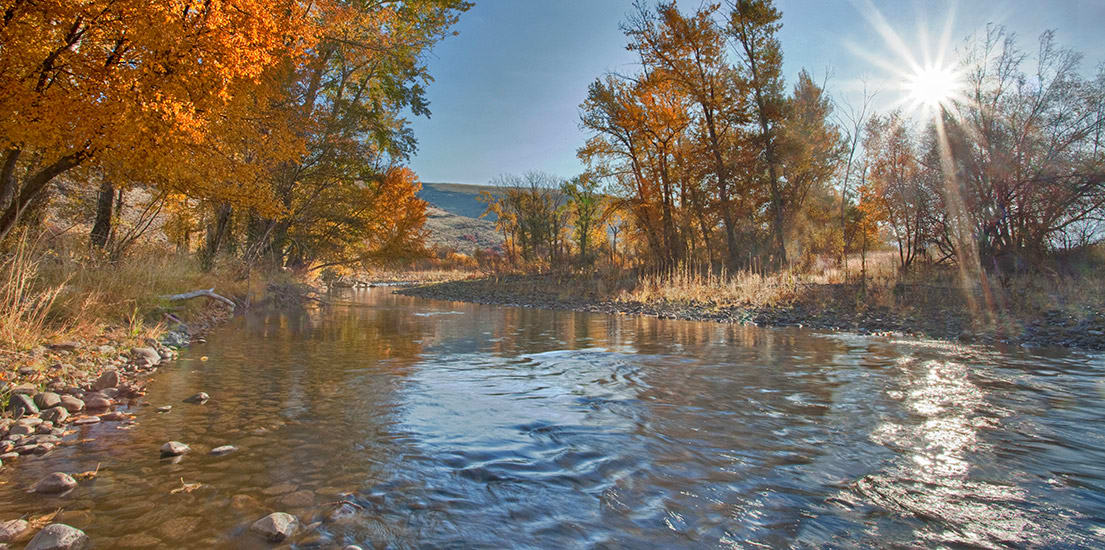If Given Half a Chance: Protecting and Restoring Catherine Creek

How have steelhead and Chinook salmon continued to survive in the upper Columbia and Snake rivers? With all the dams to negotiate, poor water quality to endure, and some degraded spawning habitat once they get there, you don’t know whether to feel sorry for these fish or simply admire their tenacity and resilience. They are survivors…if given half a chance.
Take Catherine Creek for instance. This tributary to the Grande Ronde, which is itself a trib of the Snake, has seen better days. The first irrigation project on Catherine Creek was recorded in 1863, and the following year, the first sawmill and hydropower dam was constructed along the creek in what is now the town of Union. Nowadays, the list of limiting factors for Catherine Creek is long and includes water quality (high summer temperatures), water quantity (low summer flows), excessive fine sediments (from roads, livestock grazing and timber harvest), and poor riparian condition (from channelization, overgrazing, and various other agricultural practices).
Yet, despite all this, Catherine Creek still supports wild steelhead, Chinook salmon, bull trout, and native redbands. It helps that the stream’s headwaters are in the Eagle Cap Wilderness in the W-W National Forest (that’s the “W bar W” for locals, and the Wallowa-Whitman for more distant admirers). Although the entire stream is not long—maybe 55 miles from where the North and South Forks join on down to the Grande Ronde—nearly the whole creek is rated as high priority for restoration; and it is gradually showing improvement from all the well-deserved attention.
Why high priority? Simply stated, because the fish tell us so. Studies by Oregon Department of Fish & Wildlife show that a large number of spring Chinook rear in the middle reach of Catherine Creek and that poor habitat quality in this reach is a critical factor limiting smolt production. Deep pools and slow current near cover are needed by the rearing Chinook, but are in short supply.
The reach is important as well for young native steelhead that typically smolt at two years, though some hang out in the creek for up to four years. Catherine Creek provides habitat for bull trout as well. Impressive. All these fish are migratory by nature and face myriad threats in their journeys. Making sure their spawning and rearing habitats are restored and protected can make a real difference in their survival rates; it can increase their numbers and their size and greatly improve the odds they will survive the long journeys that await them.
That is why it is important for Western Rivers Conservancy to find willing sellers with land along Catherine Creek so they can protect prime fish habitats along this important stream. That is precisely what WRC did in 2013 by purchasing a 545-acre property with frontage along both sides of the creek in the middle reach near Union. Senior water rights to boot. WRC is now working to convey the land to the Umatilla Tribe, which plans to extensively restore the stream.
It’s a great start on what should be a large “Campaign for Catherine.” Catherine Creek is precisely the kind of stream where the acquisition and restoration of some relatively small stream reaches can have huge benefits for the entire Columbia River drainage. This acquisition—and hopefully a few more down the road—just could be that “half a chance” these fish need to survive well into the future.
Jack Williams is the Senior Scientist for Trout Unlimited and serves on WRC’s Board of Directors
In early 2014, Western Rivers Conservancy purchased 545 acres along Catherine Creek to enable restoration of over two miles of this important salmon and steelhead stream. WRC is now working to convey the land to the Confederated Tribes of the Umatilla Indian Reservation. The Tribe plans to restore side-channels, replant riparian zones and stabilize stream banks in order to enhance spawning habitat and improve survival rates for over-wintering smolts.
